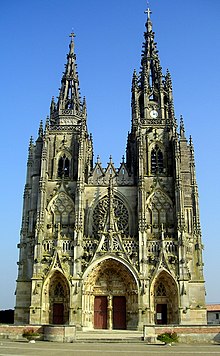Notre-Dame de l'Épine
| Basilique Notre-Dame de l'Épine | |
|---|---|

Façade of the Basilica
|
|
| 48°58′38″N 4°28′13″E / 48.97709°N 4.470408°ECoordinates: 48°58′38″N 4°28′13″E / 48.97709°N 4.470408°E | |
| Location | L'Épine |
| Country | France |
| Denomination | Roman Catholic |
| History | |
| Founded | 1405 |
| Architecture | |
| Heritage designation | World Heritage (1998) |
| Architectural type | Basilica |
| Style | Gothic Flamboyant |
| Administration | |
| Diocese | Châlons |
The Basilique Notre-Dame de l'Épine (Basilica of Our Lady of the Thorn) is a Basilica in the small village of L'Épine, Marne, near Châlons-en-Champagne and Verdun. It is a major masterpiece in the Flamboyant Gothic style.
Started around 1405-1406, construction lasted until 1527. Elevated to a basilica from 1914, Notre-Dame-de-l'Épine takes its name from the devotion given to a statue of the Virgin holding the Child Jesus. According to a legend from the 17th century that has since evolved, the statue was found by shepherds in the Middle Ages in a burning thorn bush. The basilica has the dimensions of a cathedral and is in the Gothic style. The façade has three portals and is crowned with two spires. The right spire is 55 metres (180 ft) high. The left spire was leveled in 1798 to allow the installation of a Claude Chappe telegraph. It was rebuilt in 1868.
The basilica was classified a historic monument in 1840. In 1998 it was registered on the World Heritage List by UNESCO under the title of "roads to St Jacques de Compostela in France". Notre-Dame de l'Épine has always struck travelers and inspired writers, especially Victor Hugo,Alexandre Dumas,Joris-Karl Huysmans, Paul Claudel and Paul Fort.
The basilica has remarkable gargoyles. Inside, you can admire a rood screen of the late 15th century whose right arcade houses the statue of the Virgin for which this basilica is famous.
Statues include the Venerated Virgin (about 1300), Seated virgin (15th century) and St. Jacques in wood (17th century ). The altars date from 1542, and the rood screen from the 17th century. The tribune and organ case are 16th century. The tribune is decorated with eight apostles and seven pagan gods (inscriptions added in 1825 by Father Brisson). The choir organ is from Merklin. Stained glass is from the 19th and 20th centuries, mainly manufactured by the Champigneulle house.
Gargoyle
Nave
Pipe organ
Aerial view (1914).
Lamentation of Christ
Procession in stained glass
Wall painting
...
Wikipedia

